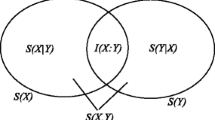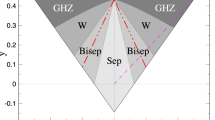Entangled states whose Wigner functions are non-negative may be viewed as being accounted for by local hidden variables (LHV). Recently, there were studies of Bell’s inequality violation (BIQV) for such states in conjunction with the well known theorem of Bell that precludes BIQV for theories that have LHV underpinning. We extend these studies to teleportation which is also based on entanglement. We investigate if, to what extent, and under what conditions may teleportation be accounted for via LHV theory. Our study allows us to expose the role of various quantum requirements. These are, e.g., the uncertainty relation among non-commuting operators, and the no-cloning theorem which forces the complete elimination of the teleported state at its initial port.
Similar content being viewed by others
References
Einstein A., Podolsky B., Rosen N., (1935). “Can quantum-mechanical description of physical reality be considered complete?”. Phys. Rev. 47, 777
Bell J.S., (1964). “On the Einstein-Podolsky-Rosen paradox”. Physics 1, 195
Bell J.S., (1966). “On the problem of hidden variables in quantum theory”. Rev. Mod. Phys. 38, 447
Bohm D., Quantum Theory (Prentice-Hall, Englewood Cliffs, NJ, 1951), Chap. 22.
Gisin N., (1991). “Bell’s inequality holds for all non-product states”. Phys. Lett. A 154, 201
J. S. Bell, “EPR correlations and EPW distributions,” in Speakable and Unspeakable in Quantum Mechanics (Cambridge University Press, Cambridge, 1987). The first (i.e., prior to Bell) to note that the Wigner function of the maximally entangled state, the so-called Rosen’s (or EPR) state: ψ(q 1,q 2) ∝ δ(q 1−q 2), viz. W(q 1,p 1,q 2,p 2) ∝ δ(q 1−q 2)δ(p 1 + p 2), may be viewed as a statistical distribution for “hidden variables” were A. M Cetto, L. de la Pena, and E. Santos, “A Bell inequality involving position, momentum and energy,” Phys. Lett. A 113, 304 (1985). Some of the early discussion is given in the article by U. Leonhardt and J. A. Vaccaro, “Quantum-optical Bell correlations in phase space,” in The Dilemma of Einstein, Podolsky and Rosen—60 Years Later (Institute of Physics Publishing, Bristol and Philadelphia, and The Israel Physical Society, Jerusalem, 1996).
Wigner E.P., (1932). “On the quantum correction for thermodynamic equilibrium”. Phys. Rev. 40, 749
K. Banaszek and K. Wodkiewicz, “Nonlocality of the Einstein-Podolsky-Rosen state in the Wigner representation,” Phys. Rev. A 58, 4345 (1998); “Testing quantum nonlocality in phase space,” Phys. Rev. Lett. 82, 2009 (1999). The interest in achieving BIQV for the EPR state is, of course, not just due to Bell’s claim noted above.
Chen Z., Pan J., Hou G., Zhang Y., (2002). “Maximal violation of Bell’s inequalities for continuous variable systems”. Phys. Rev. Lett. 88: 040406
Gour G., Khanna F.C., Mann A., Revzen M., (2004). “Optimization of Bell’s inequality violation for continuous variable systems”. Phys. Lett. A 324, 415
Revzen M., Mello P.A., Mann A., Johansen L.M., (2005). “Bell’s inequality violation with non-negative Wigner functions”. Phys. Rev. A 71: 022103
Bennett C.H., Brassard G., Crepeau C., Jozsa R., Peres A., Wootters W., (1993). “Teleporting an unknown quantum state via dual classical and Einstein-Podolsky-Rosen channels”. Phys. Rev. Lett. 70: 1895
Vaidman L., (1994). “Teleportation of quantum states”. Phys. Rev. A 49: 1473
Braunstein S.L., Kimble H.J., (1998). “Teleportation of continuous quantum variables”. Phys. Rev. Lett. 80, 869
Bouwmeester D., Pan J.M., Mattle K., Eibl M., Weinfurther H., Zeilinger A., (1997). “Experimental quantum teleportation”. Nature (London) 390, 575
Furusawa A., Sorensen J.L., Braunstein S.L., Fuchs C.A., Kimble H.J., Polzik E.S., (1998). “Unconditional quantum teleportation”. Science 282, 706
Bowen W.P., Treps N., Buchler B.C., Schnabel R., Ralph T.C., Bachor H.A., Symul T., Lam P.K., (2003). “Experimental investigation of continuous-variable quantum teleportation”. Phys. Rev. A 67: 032302
Zhang T.C., Goh K.W., Chou C.W., Lodahl P., Kimble H.J., (2003). “Quantum teleportation of light beams”. Phys. Rev. A 67: 033802
Braunstein S.L., Fuchs C.A., Kimble H.J., van Loock P., (2001). “Quantum versus classical domains for teleportation with continuous variables”. Phys. Rev. A 64: 022321
Grosshans F., Grangier P., (2001). “Quantum cloning and teleportation criteria for continuous quantum variables”. Phys. Rev. A 64: 010301
Hudson R.L., (1974). “When is the Wigner quasi-probability density non-negative?”. Rep. Math. Phys. 6, 249
Schleich W., (2001). Quantum Optics in Phase Space. Wiley-VCH, Berlin
Mann A., Revzen M., (1993). “Gaussian density matrices: quantum analogs of classical states”. Fortschr. Phys. 41, 431
Englert B.-G., Wodkiewicz K., (2003). “Tutorial notes on one-party and two-party gaussian states”. Int. J. Q. Inf. 1, 153
Shannon C.E., “A mathematical theory of communication,” Bell Syst. Tech. J. 27, pp. 379–423 and 623–656 (1948).
von Neumann J., (1955). Mathematical Foundations of Quantum Mechanics. Princeton University Press, Princeton
Popper K.R., (1959). “The propensity interpretation of probability”. Br. J. Philos. Sci. 10, 25
W. K. Wootters, “A Wigner function formulation of finite-state quantum mechanics,” Ann. Phys. (N.Y.) 176, 1 (1987). For a detailed review on the progress in quantum information based on continuous quantum variables, with emphasis on quantum optical implementations in terms of the quadrature amplitudes of the electromagnetic field, see S. L. Braunstein and P. van Loock, “Quantum information with continuous variables,” Rev. Mod. Phys. 77, 513 (2005).
Baker G.A., (1958). “Formulation of quantum mechanics based on the quasi-probability distribution induced on phase space”. Phys. Rev. 109: 2198
Hillery M., Oconnell R.F., Scully M.O., Wigner E.P., (1984). “Distribution functions in physics: Fundamentals”. Phys. Rep. 106, 121
Duan L.M, Giedke G., Cirac J.I., Zoller P., (2000). “Inseparability criterion for continuous variable systems”. Phys. Rev. Lett. 84: 2722
Simon R., (2000). “Peres-Horodecki separability criterion for continuous variable systems”. Phys. Rev. Lett. 84: 2726
Wootters W.K., Zurek W.H., (1982). “A single quantum cannot be cloned”. Nature 299, 802
Dieks D., (1982). “Communication by EPR devices”. Phys. Lett. A 92, 271
Barnum H., Caves C.M., Fuchs C.A., Jozsa R., Schumacher B., (1996). “Noncommuting mixed states cannot be broadcast”. Phys. Rev. Lett. 76: 2818
Daffertshofer A., Plastino A.R., Plastino A., (2002). “Classical no-cloning theorem”. Phys. Rev. Lett. 88: 210601
We ignore the practical difficulty of realizing the pure EPR state. Its realization requires an unbounded energy resource.
Peres A., (1996). “Separability criterion for density matrices”. Phys. Rev. Lett. 77: 1413
S. L. Braunstein, private communication.
Koniorczyk M., Kiss T., Janszky J., (2001). “Teleportation: from probability distributions to quantum states”. J. Phys. A 34: 6949
Mor T., (2006). “On classical teleportation and classical nonlocality”. Int. J. Quant. Inf. 4, 161
Caves C.M., Wodkiewicz K., (2004). “Classical phase-space descriptions of continuous-variable teleportation”. Phys. Rev. Lett. 93: 040506
Author information
Authors and Affiliations
Corresponding author
Additional information
Communicated by Alwyn van der Merwe
Rights and permissions
About this article
Cite this article
Kalev, A., Mann, A. & Revzen, M. Local Hidden Variables Underpinning of Entanglement and Teleportation. Found Phys 37, 125–143 (2007). https://doi.org/10.1007/s10701-006-9092-6
Received:
Revised:
Published:
Issue Date:
DOI: https://doi.org/10.1007/s10701-006-9092-6




